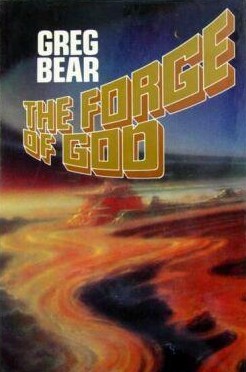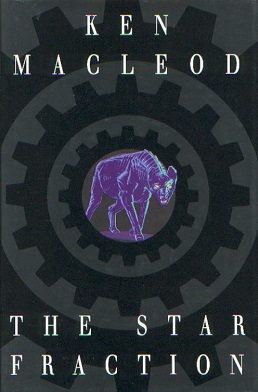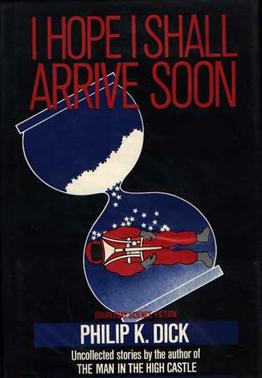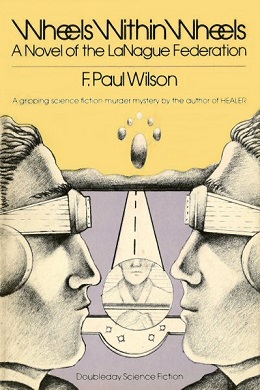
Gregory Dale Bear was an American writer and illustrator best known for science fiction. His work covered themes of galactic conflict, parallel universes, consciousness and cultural practices, and accelerated evolution. His last work was the 2021 novel The Unfinished Land. Greg Bear wrote over 50 books in total.

The Forge of God is a 1987 science fiction novel by American writer Greg Bear. Earth faces destruction when an inscrutable and overwhelming alien form of life attacks.

Blood Music is a science fiction novel by American writer Greg Bear. It was originally published as a short story in 1983 in the American science fiction magazine Analog Science Fact & Fiction, winning the 1983 Nebula Award for Best Novelette and the 1984 Hugo Award for Best Novelette.

The Memory of Whiteness is a science fiction novel written by Kim Stanley Robinson and published in September 1985.

The Restaurant at the End of the Universe is the second book in the Hitchhiker's Guide to the Galaxy comedy science fiction "trilogy" by Douglas Adams, and is a sequel. It was originally published by Pan Books as a paperback in 1980. The book was inspired by the song "Grand Hotel" by British rock band Procol Harum. The book title refers to Milliways, the Restaurant at the End of the Universe, one of the settings of the book. Elements of it are adapted from the radio series, primarily the Secondary Phase, although Milliways itself, Arthur and Ford's final fate come from Fits the Fifth and Sixth of the Primary Phase.

The Lazarus Effect (1983) is the third science fiction novel set in the Destination: Void universe by the American author Frank Herbert and poet Bill Ransom. It takes place some time after the events in The Jesus Incident (1979).

Gilgamesh the King is a 1984 historical novel by American writer Robert Silverberg, presenting the Epic of Gilgamesh as a novel. In the afterword the author wrote "at all times I have attempted to interpret the fanciful and fantastic events of these poems in a realistic way, that is, to tell the story of Gilgamesh as though he were writing his own memoirs, and to that end I have introduced many interpretations of my own devising which for better or for worse are in no way to be ascribed to the scholars".

David Rowland Langford is a British author, editor, and critic, largely active within the science fiction field. He publishes the science fiction fanzine and newsletter Ansible and holds the all-time record for most Hugo Awards, with a total of 29 wins.

Tik-Tok is a 1983 science fiction novel by American writer John Sladek. It received a 1983 British Science Fiction Association Award.

Man of Two Worlds (1986) is a science fiction novel by American writers Brian and Frank Herbert.

The Star Fraction is a science fiction novel by Scottish writer Ken MacLeod, his first, published in 1995. The major themes are radical political thinking, a functional anarchist microstate, oppression, and revolution. The action takes place in a balkanized UK, about halfway into the 21st century. The novel was nominated for the Arthur C. Clarke Award in 1996.

Eon is a science fiction novel by American author Greg Bear published by Bluejay Books in 1985. Eon was nominated for an Arthur C. Clarke Award in 1987. It is the first novel in The Way series; followed by Eternity.
A Farcaster is an instantaneous transportation device in the fictional Hyperion universe. Farcasters allow two points separated by a vast distance to be brought together at a "Farcaster Portal". The Farcaster network connects hundreds of planets of the Hegemony of Man into their WorldWeb. The Farcaster network allowed transport between connected worlds without any time discrepancy, unlike Hawking drive (Faster-than-light) transport provided by spaceships of the Hegemony era. The Farcaster was developed by the Artificial Intelligences (AIs) of the TechnoCore and given to humanity sometime after the Hegira.

Software is a 1982 cyberpunk science fiction novel written by Rudy Rucker. It won the first Philip K. Dick Award in 1983. The novel is the first book in Rucker's Ware Tetralogy, and was followed by a sequel, Wetware, in 1988.

The concepts of space stations and space habitats feature in science fiction. The difference between the two is that habitats are larger and more complex structures intended as permanent homes for substantial populations, but the line between the two is fuzzy with significant overlap and the term space station is sometimes used for both concepts. The first such artificial satellite in fiction was Edward Everett Hale's "The Brick Moon" in 1869, a sphere of bricks 61 meters across accidentally launched into orbit around the Earth with people still onboard.
Paul le Page Barnett, known by the pen name of John Grant, was a Scottish writer and editor of science fiction, fantasy, and non-fiction.

I Hope I Shall Arrive Soon is a book by American writer Philip K. Dick, a collection of 10 science fiction short stories and one essay. It was first published by Doubleday in 1985 and was edited by Mark Hurst and Paul Williams. Many of the stories had originally appeared in the magazines Fantasy and Science Fiction, Worlds of Tomorrow, Amazing Stories, Interzone, Rolling Stone College Papers, The Yuba City High Times, Omni and Playboy.

Wheels Within Wheels is a novel by F. Paul Wilson published in 1978.
Empire of the East is a novel by Fred Saberhagen published in 1979.

The far future has been used as a setting in many works of science fiction. The far future setting arose in the late 19th century, as earlier writers had little understanding of concepts such as deep time and its implications for the nature of humankind. Classic examples of this genre include works such as H.G. Wells' The Time Machine (1895) or Olaf Stapledon's Last and First Men (1930). Recurring themes include themes such as Utopias, eschatology or the ultimate fate of the universe. Many works also overlap with other genres such as space opera, science fantasy or apocalyptic and post-apocalyptic fiction.

















